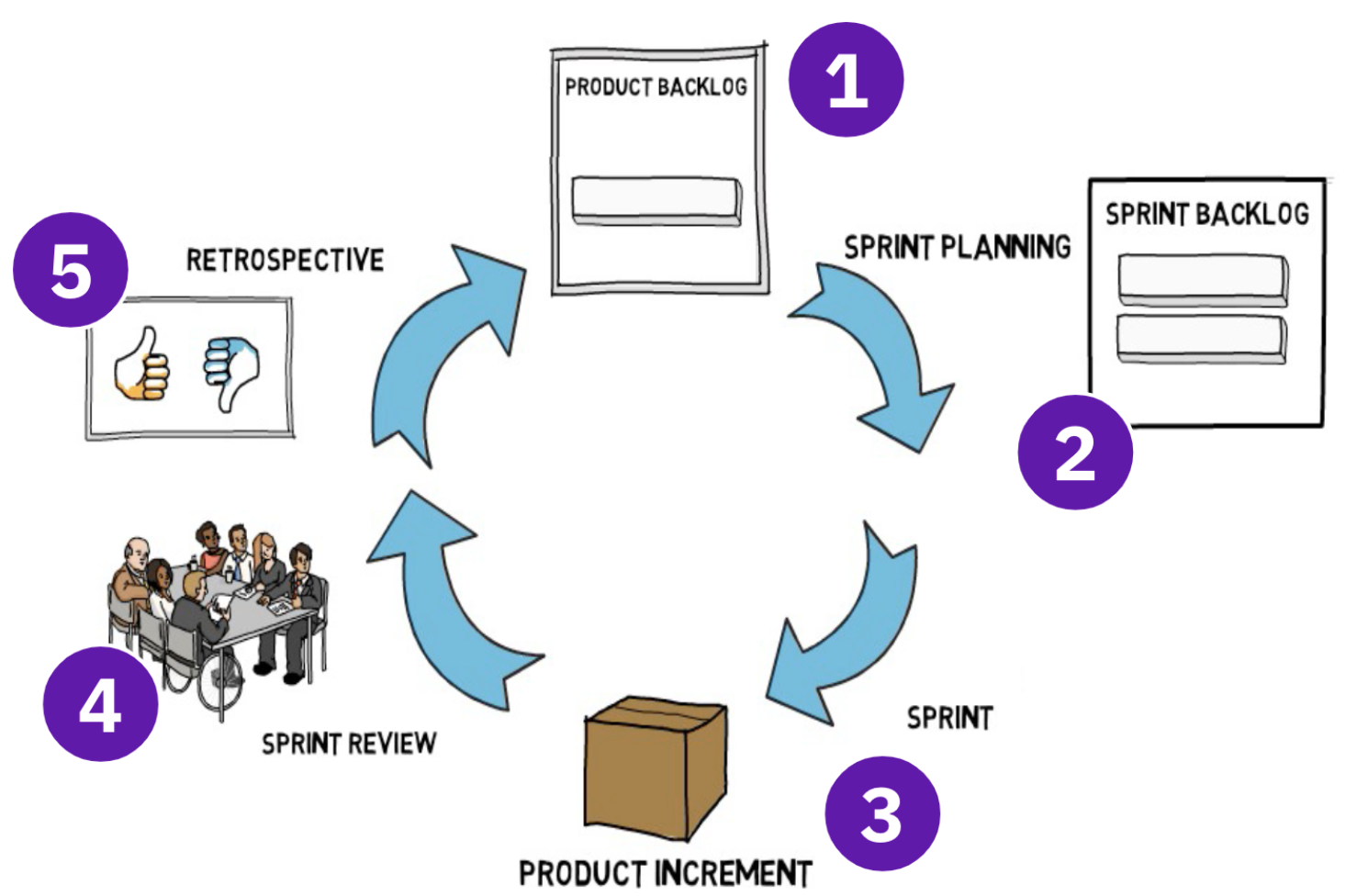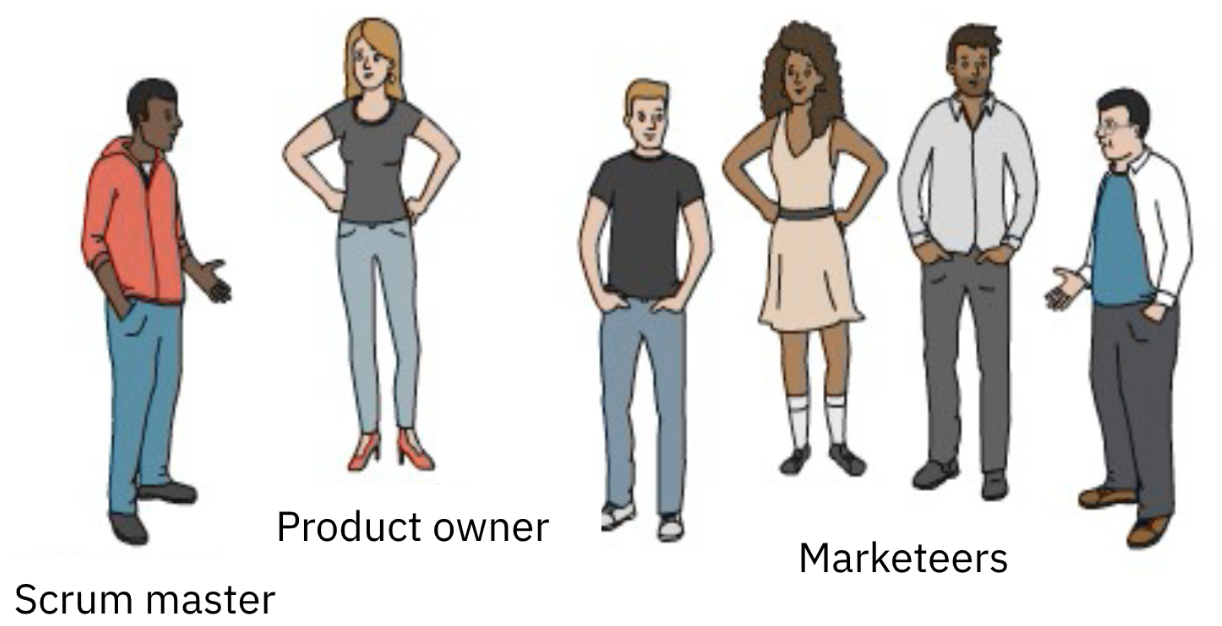“Stress in the marketing department, bulky marketing plans, and poor collaboration. We. Don’t. Want. It. Anymore.” Yes, it’s usually easy to say what you no longer want, right? And okay, it’s fine to feel that pain for a moment. But how do you make the step towards what you do want as a marketing team?
In this article, I will free you from the dark clouds that sometimes hang over your marketing team. Why will Agile marketing help you? Let’s discover the advantages together based on a concrete practical case from a software company.
Today’s Deep Dive
You’ve probably noticed, I’ve written quite a bit about working Agile in marketing recently. Today, we apply this knowledge further. I’ll give you a practical example of a software company developing a marketing campaign based on Agile and Scrum. Let’s dive in!
The case
Lets’ say you are responsible for the marketing team at an IT company. You create an annual plan every year but during the kickoff of this year, you have to defend yourself vigorously against the board. “Why was the previous plan only partially executed?” and “We see that the budget has significantly shifted to other initiatives, why is that?”. These are critical questions that come back almost every year.
And of course, they are defendable. As a software company, you work in a rapidly changing market. But still, they have a point. Additionally, the collaboration with sales could better too. But what you struggle with the most is the workload. Your best people experience a level of stress that is not healthy. In this market, you can’t afford to have a recruiter run off with your talent. Something needs to change. You take a moment to organize your thoughts and make the following list:
Challenges
- Reducing stress and frustration in your team
- No longer wanting to write and execute big plans (they never come to fruition anyway)
- Being able to change course more quickly based on market feedback
Opportunities
- Collaborate better with sales to increase the impact of marketing
- Be able to change the marketing strategy more quickly
- Work more consciously and effectively while focussing on the right tasks
Vision
- The annual planning cycle no longer feels contemporary and you want to move away from it. Instead, you want to work with shorter planning cycles.
- You want better insight into the quantity and scope of work that needs to be done and want team members to determine among themselves who does what, when and how.
- You want to invest in a sustainable work pace to reduce stress. Moreover, you want to involve everyone in planning the work and evaluating the outcomes.
Scrum as the foundation
During the marketing meeting, your team agrees, something needs to happen. Agile, rapid iteration, self-direction, engaged teams; Working Agile seem like a solution for the challenges you want to tackle in your team. After a short presentation, your team is excited. They are especially glad that something is going to happen.
You decide to embrace Agile practices based on Scrum. Scrum is a lightweight framework that helps people, teams and organizations create value through adaptive solutions to complex problems such as marketing campaigns.
Scrum Values
Successful use of Scrum depends on becoming proficient in adhering to the following five values:
Commitment, Focus, Openness, Respect and Courage
These Scrum Values guide the team in their work, actions, and behavior. Team members learn and discover these values while working with Scrum events and so-called artifacts (more on this later).
It is often said, “Scrum is easy to understand but difficult to master.” This is partly due to these values. Please realize that the Scrum Values do not necessarily match the values within your company, and this can cause friction. Adopting Scrum often also requires a transformation of your company’s values.
How to get started?
For the upcoming quarter, a campaign is needed to generate new leads for your software solution. The campaign targets coaches and entrepreneurs who want to spend less time scheduling appointments with (potential) clients.
These are the key components of the campaign:
- A series of 5 blogs based on a keyword analysis
- A whitepaper promoted via LinkedIn Ads and owned channels
- A webinar promoted via LinkedIn Ads, remarketing and owned channels
- An email drip campaign using marketing automation
- A series of 16 social media updates
As the person in charge of the marketing team, you are delighted with your team’s enthusiastic response. The question, “Why work Agile?” is no longer asked. You are getting started concretely! You have a clear start with the above campaign and your team is eager to approach things differently this time. Even management is excited.
1. Get executive support
An Agile transformation requires buy-in from the top. Secure support from senior leadership by showing how other companies drive business value and increase employee satisfaction with Agile and Scrum.
Also ensure that your marketing objectives align with the broader goals of your organization. Agile marketing should support and enhance the company’s strategic priorities.
2. Educate and train the team
Since this is the first time your team will use Scrum and Agile practices, you organize a workshop. This includes attention to the Agile mindset and the Scrum framework. You show how others handle the iterative process.
You also consider the so-called Scrum artifacts: the Product Backlog, the Sprint Backlog, and the Increment. You also discuss all the events that take place during a Sprint: the Sprint Planning, the Daily Scrum, the Sprint Review, and the Sprint Retrospective. Additionally, you will start creating the first backlog items and formulating a Sprint Goal.

One team, focused on one goal
A Scrum Team is a unit of professionals focused on a single goal. The team is small enough to remain agile and large enough to complete meaningful work within a Sprint. Typically, a Scrum Team consists of 10 or fewer people. Oh, and importantly: there are no sub-teams or hierarchies within the team!
3. Let the team self-organize itself
The most powerful Scrum Teams determine their own composition. As part of your new direction, the team will distribute responsibilities (in Scrum, you no longer talk about roles). The Scrum Team has the following responsibilities: one Scrum Master, one Product Owner and Developers.

3.1 Scrum Master
The Scrum Master is responsible for setting up Scrum and the effectiveness of the Scrum Team. He or she serves the Scrum Team, the Product Owner and the organization through coaching, training and support in Scrum.
3.2 Product Owner
The Product Owner is responsible for maximizing the value of the work the Scrum Team performs. This means that the Product Owner organizes the work so that the most important stakeholders (sales and the executive board in our example) perceive the outcome of a Sprint as valuable. Another responsibility of the Product Owner is to create and clearly communicate Product Backlog items.
3.3 Developers / Marketeers
Scrum has its roots in software development and uses the term ‘Developers‘ for those who do the work. As the use of Scrum spreads, developers, researchers, analysts, marketers and other specialists do the work. Scrum uses the term ‘Developers’ to simplify, not to exclude. In our example, the Developers are therefore your colleague Marketers.
The most powerful Scrum Teams determine their own team composition. The goal is to have the team select a Product Owner, a Scrum Master, and the Developer. Note that in smaller teams, a Product Owner and Scrum Master can also be a Developer. Make sure you provide good guidance for this process as existing marketing teams may find this challenging.
4. Opt for a digital or physical Scrum board
A Scrum board helps you visualize and clarify your tasks. Tasks (or user stories) are noted on post-its and divided into columns. This makes the work that needs to be done visible to the entire team and makes it easier to organize. Starting with a board is not difficult For example, you can use a whiteboard with four columns: Backlog, To-Do, In Progress and Done.
You can opt for a digital or physical Scrum board. The physical version is set up on a large wall where you use tape to indicate columns. You use post-its to note tasks. For a digital version, consider solutions like Trello or Jira.
Expanding Scrum knowledge
A motto of Scrum is “Try Scrum as it is and determine if it helps you achieve goals and create value”. The Scrum framework is purposefully incomplete and defines only the parts necessary to implement Scrum theory. Help your team by sharing and discussing the Scrum Guide 2020 with them beforehand.
5. Brainstorm and determine Product Backlog Items
You can get started! As a team, you reflect on the campaign that needs to be developed. The coming hour is dedicated to identifying the actions necessary to realize the campaign. From writing blogs to creating landing pages; each action becomes a Product Backlog Item. Soon a substantial list forms, hence the need to group actions into Epics. An Epic comprises several PBIs and essentially describes a larger amount of work.
These are the Epics you identify:
- Blog series
- Social media
- Email marketing and marketing automation
- Landing pages and website changes
- Webinar
- Whitepaper
- Online advertising
All items are placed in the ‘Backlog’ column. “Well, that’s a nice overview,” you think to yourself.
6. Together, determine which PBIs become part of your first Sprint
The start of the Sprint is characterized by the Sprint Planning meeting. In this meeting, you outline the work that you want to carry out during the Sprint. The first Sprint has not formally started yet, but it’s good to get a head start on the first Sprint Planning meeting. Therefore, you look closely at all the items in the Product Backlog together and discuss which items you want to achieve in the upcoming two weeks. This becomes your Sprint Backlog.
7. Discuss the Sprint Backlog, estimate each Item and select an owner
Now that the Sprint Backlog is taking shape, you also make an estimation of the size of each item on it together. You critically assess the complexity and availability of the team during the Sprint. The Planning Poker app is recommended to support this activity.
Together, you also assess what is needed to complete each Product Backlog Item and add this to each item in the form of a plan. Refining PBIs, by the way, is something that can always take place. It ensures that the work becomes even clearer.
Lastly, you assign an owner to each item on the Sprint Backlog.
Estimating based on time or Story Points?
Scrum does not have a guideline on how to estimate the size of the work. Many teams therefore start by estimating based on time (hours). However, it is advisable to make work estimates based on points, also known as Story Points.
Why Story Points? It is nearly impossible to accurately estimate a task in hours. A key reason for this is that your output in an hour is not the same as mine. Ask two marketers to estimate the same task and you will get two different answers. Both professionals do not have the same knowledge and experience. Moreover, we do not know all the requirements of the backlog item in advance (a characteristic of complex work).
In a future blog, we will definitely delve deeper into the concept of Story Points. For now, remember that Story Points are a proven technique for making a first estimate of the work. Therefore, start using this method now so that you can develop this habit. This blog will help you along the way.
8. Start the first Sprint
Finally! The time has come. The Sprint is about to begin. Do not be misled by the term Sprint. It has nothing to do with performing the work as quickly as possible. Sprints are meant to create a sustainable work pace in your team. Think of it more like the pace of a marathon, which you also run at a sustainable speed to reach the finish line. For this reason, among others, overtime is not valued in Scrum Teams. Overtime leads to fatigue and stress, which you specifically wanted to reduce!
Also good to know: Sprints have a fixed length and you almost never change this. And because a new Sprint starts immediately after the previous one ends, a predictable rhythm is created for the team. This ensures consistency and reduces complexity.
9. Meet daily and discuss progress (Daily Scrum)
“Are we also going to do standups?” asks your colleague marketer. You go all-in, so your team meets every morning for 15 minutes. The purpose of the Daily Scrum (also called a standup by some) is to discuss the progress of the Sprint, possibly adjust the Sprint Backlog and have a plan for the next 24 hours. The team chooses the structure and technique they want to use for this.
For example, all team members answer the following three questions:
- What have I achieved since the last standup?
- What do I want to achieve today?
- What is holding me back and who can help me with it?
These Daily Scrums improve communication, identify impediments and help the team make decisions quickly. As a result, the Daily Scrum eliminates the need for other meetings. For this reason, you also decide to skip the weekly meeting from now on.
10. Review the Sprint after two weeks (Sprint Review)
The Sprint Review is an interactive work session, not a one-sided presentation. The Scrum Team actually demonstrates what it has achieved and discusses this with the Product Owner and stakeholders. Together, you evaluate the progress and discuss what needs to happen in the next Sprint. Based on this, you can also adjust the Marketing Product Backlog to seize new opportunities.
During the review, it is important that open and honest communication occurs among all participants. The Scrum Team shows only the work that has been completed, but also discusses what has not been successful and why. The feedback and discussion that arise from this help to collectively determine what the next steps are and whether adjustments are needed to achieve the Product Goal.
11. Improve quality and effectiveness (Retrospective)
Before you know it, the two weeks have flown by. It took some getting used to and the process was not flawless, but apart from a few Product Backlog Items, the work you had predicted was done. The Scrum board has been well utilized and the team is enthusiastic about the simple system.
At the end of the Sprint, you reflect and look at what can be improved over the next two weeks. This is called the Sprint Retrospective. Here too, the team chooses the structure and technique they want to use for this. For example, team members jot down answers to the following questions and discuss them with each other:
- What went well? (You want to repeat this)
- What did not go so well? (You want to eliminate or avoid this)
- What new ideas do we have? (Suggestions and improvements that you want to test in the upcoming Sprint)
12. Learn and repeat 
After the Retrospective, the next Sprint begins with a Sprint Planning meeting. Here, you determine the work for the coming two weeks and repeat the steps above.
Need Help?
Consider hiring an experienced Agile Coach or Scrum Master. Additionally, invest in knowledge within the team about Agile principles and the Scrum framework. It definitely increases the chances of success for your Agile marketing campaign.
Your next step
What are you waiting for? Your marketing team can easily start with Agile marketing based on Scrum. Begin by identifying a first project you want to use to familiarize yourself with Agile marketing and Scrum. Which campaign do you have planned that you could start realizing?
Over to you
I’m curious: is Agile marketing a far-fetched idea for you? Or do you see it as a serious alternative for organizing work in your marketing team?



